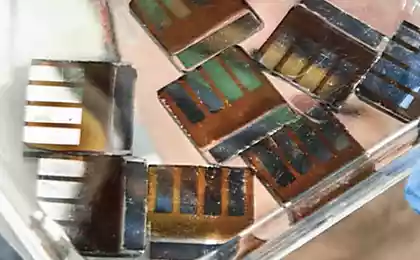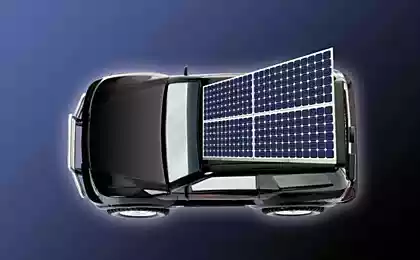437
Scientists from China have developed an inexpensive flexible solar cells from perovskite
Recently, Chinese scientists from Fudan University in Shanghai has introduced solar cells, flexible fibers that can be woven into textiles. The flexible, coaxial cells, developed from nanotubes of perovskite and of carbon, provide excellent conversion efficiency of 3.3 percent and low cost of production.
Today's solar panels are either inexpensive and inefficient, or have reasonable efficiency, but are quite expensive. One solution to this dilemma is the use of perovskite, which, unlike silicon, has low cost and requires no expensive additives. Perovskites are a group of materials having special crystalline structure similar to the structure of calcium titanate, which are semiconductors and absorb sunlight. But most importantly, they can move electrons, excited by photons at large enough distances within the crystal lattice before they return to normal energy state – this property is very important for manufacturing highly efficient solar cells.
Chinese researchers were able to develop solar panels from perovskite in the form of flexible fibers, so thin that they can be woven into the fabric. The production process of such flexible solar cells are a relatively simple and inexpensive because it uses the technology of build-up layers.
The fiber core is the anode, made of thin stainless steel wire coated with a compact layer of the semiconductor titanium dioxide. On top of this layer is deposited a layer of porous nanocrystalline titanium dioxide, which provides a large surface area for subsequent coats of the perovskite CH3NH3PbI3. Then follows a layer of an organic material and a transparent layer of carbon nanotubes that is used as the cathode.
The perovskite layer absorbs solar rays, which excite electrons, causing them to go into a higher energy state, and leave in their place a positively charged "holes". Electrons enter into a compact layer of titanium dioxide and move to the anode, and holes are captured in this organic layer. The large surface area and high conductivity of the carbon nanotubes of the cathode help the rapid charge transfer. As the researchers claim, the effectiveness of new fiber solar panels exceeds that of the solar cells with dyes or on the basis of polymers.
Source: www.cheburek.net
Today's solar panels are either inexpensive and inefficient, or have reasonable efficiency, but are quite expensive. One solution to this dilemma is the use of perovskite, which, unlike silicon, has low cost and requires no expensive additives. Perovskites are a group of materials having special crystalline structure similar to the structure of calcium titanate, which are semiconductors and absorb sunlight. But most importantly, they can move electrons, excited by photons at large enough distances within the crystal lattice before they return to normal energy state – this property is very important for manufacturing highly efficient solar cells.
Chinese researchers were able to develop solar panels from perovskite in the form of flexible fibers, so thin that they can be woven into the fabric. The production process of such flexible solar cells are a relatively simple and inexpensive because it uses the technology of build-up layers.
The fiber core is the anode, made of thin stainless steel wire coated with a compact layer of the semiconductor titanium dioxide. On top of this layer is deposited a layer of porous nanocrystalline titanium dioxide, which provides a large surface area for subsequent coats of the perovskite CH3NH3PbI3. Then follows a layer of an organic material and a transparent layer of carbon nanotubes that is used as the cathode.
The perovskite layer absorbs solar rays, which excite electrons, causing them to go into a higher energy state, and leave in their place a positively charged "holes". Electrons enter into a compact layer of titanium dioxide and move to the anode, and holes are captured in this organic layer. The large surface area and high conductivity of the carbon nanotubes of the cathode help the rapid charge transfer. As the researchers claim, the effectiveness of new fiber solar panels exceeds that of the solar cells with dyes or on the basis of polymers.
Source: www.cheburek.net
The extreme jump from the fifth floor to the pool (video)
The housing of the future can be tested by anyone























